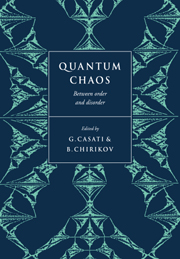Book contents
- Frontmatter
- Contents
- Preface
- Acknowledgments
- Introduction
- Part One Classical chaos and quantum localization
- Part Two Atoms in strong fields
- Part Three Semiclassical approximations
- Part Four Level statistics and random matrix theory
- Characterization of chaotic quantum spectra and universality of level fluctuation laws
- Quantum chaos, localization and band random matrices
- Structural invariance in channel space: a step toward understanding chaotic scattering in quantum mechanics
- Spectral properties of a Fermi accelerating disk
- Spectral properties of systems with dynamical localization
- Unbounded quantum diffusion and fractal spectra
- Microwave studies in irregularly shaped billiards
- Index
Unbounded quantum diffusion and fractal spectra
Published online by Cambridge University Press: 07 May 2010
- Frontmatter
- Contents
- Preface
- Acknowledgments
- Introduction
- Part One Classical chaos and quantum localization
- Part Two Atoms in strong fields
- Part Three Semiclassical approximations
- Part Four Level statistics and random matrix theory
- Characterization of chaotic quantum spectra and universality of level fluctuation laws
- Quantum chaos, localization and band random matrices
- Structural invariance in channel space: a step toward understanding chaotic scattering in quantum mechanics
- Spectral properties of a Fermi accelerating disk
- Spectral properties of systems with dynamical localization
- Unbounded quantum diffusion and fractal spectra
- Microwave studies in irregularly shaped billiards
- Index
Summary
Abstract
A few years ago we found the existence of an unbounded quantum mechanical diffusion process which strongly contrasted with the dynamical localization of the kicked rotator and other previously studied quantum systems. Here we review how this phenomenon is related to multifractal properties of the spectrum, its level statistics, and to the algebraic decay of correlations. We investigate the influence of classical chaos on uncountable fractal spectra and demonstrate that the concepts of level statistics can be related to multifractal concepts in these cases. First we point out a new class of level statistics where the level spacing distribution follows inverse power laws p(s) ∼ s−β with 1 < β < 2 and β = 1 + D0 where D0 is the fractal dimension of the spectrum. It is characteristic of hierarchical level clustering rather than level repulsion and appears to be universal for systems exhibiting unbounded quantum diffusion where the mean square displacement increases as t2δ with δ = β − 1. A realization of this class with β = 3/2 is a model of Bloch electrons in a magnetic field (Harper's equation), for which lateral surface superlattices on semiconductor heterojunctions presently serve as experimental realizations. While here diffusion is linear in time (δ = 1/2), in the Fibonacci chain model the spread of wave packets also shows anomalous diffusion (δ ≠ 1/2) with 0 < δ < 1.
- Type
- Chapter
- Information
- Quantum ChaosBetween Order and Disorder, pp. 633 - 660Publisher: Cambridge University PressPrint publication year: 1995
- 1
- Cited by

